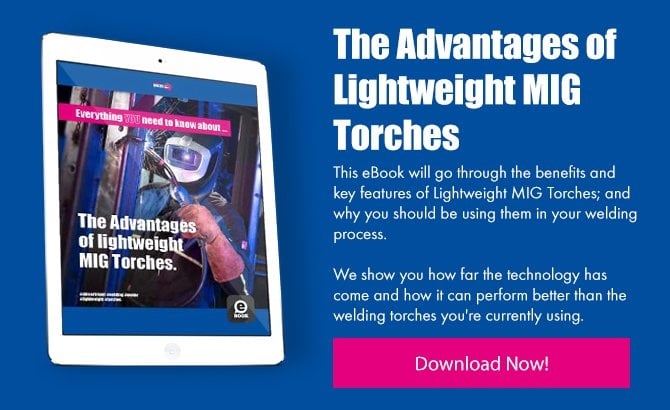When you’re running a shop day to day or looking at solutions that can save you time and get you running more efficient, knowledge is power. Knowing what options are out there that can fit your welding operation’s unique needs can go a long way to getting your production floor at that optimal level of being productive, cost-effective, convenient, and comfortable.
Sadly, most don’t know ALL the options that are out there and available to them for their MIG guns. Sure, you might know some, or maybe you’ve heard of them. But do you know how they work? Or why they exist in the first place, or how they can benefit you?
We’ve identified 6 MIG gun options out there that can save you time and cut your operating cost without really having to change anything drastic on your production floor:
Lockout and Dual Schedule Triggers
Probably the most common option for MIG gun triggers that operators ask for that are pretty widely available. These would be dual schedule triggers or a trigger locks. These trigger options come either via an auxiliary button or a dual pull switch is integrated into the main.
A lot of welding gun makers offer something like a lock out trigger (but not all), and the main benefit is that it allows welders to electrically operate the trigger and lock it out. Think of it as cruise control for welding. You pull the trigger once and it locks into place, allowing you just have to guide the welding gun’s front end through the work piece to get a quality weld. If you hit it again, it will stop feeding wire. This option is very effective for when you’re performing long welds because it helps significantly in reducing strain while operating and allows the physical focus to be placed on guiding the wire properly.
This option is very effective for when you’re performing long welds because it helps significantly in reducing strain while operating and allows the physical focus to be placed on guiding the wire properly.
Neckliners
Another option that is used a lot – though not as often as they probably should be – is the use of neckliners with your MIG gun. We touch on this in a lot of videos and blog posts and the reason is simple: neckliners are tremendous time savers in the production line and almost always lower the overall operating cost of the welding gun.
To remind you, the main cable liner is a wear item consumable, and generally where it wears the most is on the bend of the neck. Any MIG gun that uses a removable style swanneck (think ABIMIG or DELTA welding guns) can use neckliners, and it’s equally suitable for manual and robotic applications provided you can naturally detach the swanneck from the front housing.
 In the case of the neckliner, you can change out just that front portion or the liner where it’s going to wear the most, in just a matter of seconds, as opposed to using full length cable liners where you have to take the welding gun off feeder, pull the liner out, insert the new liner, cut to length, and feed the wire through all over again. That’s a process that can take as much as 30 minutes depending how skilled or fast the operator or maintenance person is, and that’s all lost time on the production floor.
In the case of the neckliner, you can change out just that front portion or the liner where it’s going to wear the most, in just a matter of seconds, as opposed to using full length cable liners where you have to take the welding gun off feeder, pull the liner out, insert the new liner, cut to length, and feed the wire through all over again. That’s a process that can take as much as 30 minutes depending how skilled or fast the operator or maintenance person is, and that’s all lost time on the production floor.
It gets asked frequently if a welder needs to use the same material on the neck liner as he does the wire liner. It’s a good question, and often the answer is yes, it is recommended but there are definite exceptions to that general rule. For instance, if you’re running aluminum wire or an abrasive wire or using the welding gun to do something like hardfacing, you can (and should) run a Teflon liner for the whip, or a combination liner that uses brass for the neck portion because brass will wear much better and resist more heat as opposed to teflon, which can get softer and stickier when it gets heated.
Narrow Gap Welding Consumables
Another option on your MIG gun you may not know about is tapered or narrow gap consumable. Tapered consumables are made for both manual and robotic applications where you need to get into very difficult to weld joints that are hard to reach with standard style, everyday off the shelf welding consumables with.
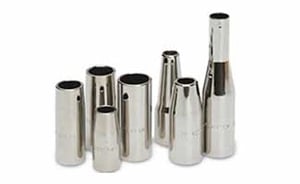 Tapered consumables are used a lot in pipe welding to make a root weld where a welder needs to get in a tight access area. It’s asked because of the narrow gap of that nozzle bore whether or not you get problems with gas flow given the small opening. Typically, that is not a concern, but sometimes in automated applications you can risk welding faster than what your gas can cover. Smaller consumables produce a smaller area of gas coverage, and that nozzle can outrun the gas coverage/column if the robot is programmed to move too quickly. This is less of any issues in manual processes and very easily correctable in the rare instances it happens.
Tapered consumables are used a lot in pipe welding to make a root weld where a welder needs to get in a tight access area. It’s asked because of the narrow gap of that nozzle bore whether or not you get problems with gas flow given the small opening. Typically, that is not a concern, but sometimes in automated applications you can risk welding faster than what your gas can cover. Smaller consumables produce a smaller area of gas coverage, and that nozzle can outrun the gas coverage/column if the robot is programmed to move too quickly. This is less of any issues in manual processes and very easily correctable in the rare instances it happens.
For material selection, tapered nozzles will usually come in either nickel plated copper or brass from some welding gun manufacturers. Know that with brass nozzles they will wear faster than a plated nozzle because they have less spatter resistance and incur more every day wear and tear because they’re more brittle.
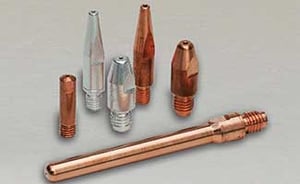 With tapered contact tips there is less surface area on the tip itself, so something to keep in mind as you evaluate them. It’s not a robustly built contact tip like an M8 or M10 style. Any narrow gap style contact tip has to be elongated to match the inner diameter shape of the nozzle to get that adequate wire stick-out. Tapered contact tips may not give you as much wear life as a standard style tip. Typically, what I tell welders and production managers is to use a narrow gap setup when you need to, and don’t rely on it as an everyday setup.
With tapered contact tips there is less surface area on the tip itself, so something to keep in mind as you evaluate them. It’s not a robustly built contact tip like an M8 or M10 style. Any narrow gap style contact tip has to be elongated to match the inner diameter shape of the nozzle to get that adequate wire stick-out. Tapered contact tips may not give you as much wear life as a standard style tip. Typically, what I tell welders and production managers is to use a narrow gap setup when you need to, and don’t rely on it as an everyday setup.
As far as concerns about how limited tapered consumable are for parameters, know that most narrow gap consumables in manual applications will come in at around 300 amp rated, so if you’re welding at high parameters and needing to use narrow gap consumables you can expect some premature wear. This is partially why it’s not recommended to use as an everyday setup. For robotic applications on tapered consumables, 500 amp water-cooled setups are possible. These tapered tips can be made in standard copper, or for very high-amperage applications a silver-plated copper at up to .045 wire.
Welding Gun Connector Kits
Another option on your MIG guns that are not widely used but can really make it easier for the tool crib and the shop floor are rear connector pin kits.
Generally speaking, there’s a lack of awareness about kits like that and operate under the assumption that once you buy a welding gun and it’s set up for feeder X, that you can never switch it over to feeder A or B without taking the rear housing completely apart. Say that you have a welding gun setup for a Lincoln welder, and want to change to a Miller welder. The conventional thought among any is either you have a get a different welding gun fitted for that Miller style connector, or you need to switch both feeders to a Euro-style feeder and get a Euro-connect welding gun. There are other and more convenient options than that, however, and it’s using rear connector kits.

With connector kits, switching out for a different welding machine is just a matter of unthreading the power pin, putting the kit in for the new machine setup, possibly changing out the wire liner because the length of the liner may vary, then going right back to welding. The whole process usually takes less than a 5 minute to change out for a well-practice maintenance technician or welder. It takes minimal tools – just a screwdriver, a hex wrench, and a crescent wrench (and sometimes less tools than that). The ability to adapt a welding gun from one feeder to another is very easy, convenient, and maintenance-friendly.
Sometimes shops have concerns about losing conductivity on that rear pin when you switch it out with a connector kit. In every case I’ve had, so long as that adapter pin is installed correctly you’ll suffer no loss of amperage or conductivity through the welding gun lead as a result. A well-design welding gun will use a universal block on the rear housing, and those blocks will accept any connector pin. Some weld shops in my experience that have a variety of machines will get MIG guns without a feeder pin and then order connector pins on an as-need basis a la carte style to feed to pin to the feeders they need.
Customized Swannecks
On the opposite end of the rear connect is the swanneck. Much like rear pin connects, you can similarly use swanneck that have different lengths, different bends, are flexible, or suit any job you have. It’s as easy normally as unthreading the base of the swanneck and swapping it out on an as need basis.
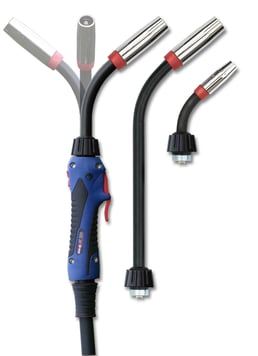
There are a lot of shops out there that are unaware of all the different neck options available to them for different jobs and demands, reaches, and accesses. It’s important to know you don’t need to necessary match up your swanneck neck rating to your welding gun cable rating (although it is recommended). For instance, say you have a 400 amp rated welding gun cable, but you have some applications calling for really tight access and you need a neck that gets the welder that kind of but it’s rated for 250 amp. So long as you’re using the same welding gun and swanneck model that’s not a problem. That neck will be the weaker link, and you will de-rate the amperage of the cable to match the neck, but you’ll still get the access you need to those tight welds and tight joints without having to buy a whole new gun.
Flex necks are other good options for those tight access joints. It is highly recommended to use a neck liner with a flex neck or anytime you’re swapping swannecks to jobs in general. Swanneck lengths can be as long as several feet in some cases and as short of a couple inches depending on the access need. Bends in swannecks can vary anywhere from 22 degree to even up to 90 in special applications (usually most won’t exceed 60 degree on the bend). There’s a lot variety for customer to meet any needs you might have.
Maintenance Friendly, Replaceable Whips
With the design of these weld guns it’s important that they are user-friendly and built for maintenance. Understandably, most manufacturers would rather be able to repair these welding guns on site than constantly have to replace them because they’re too difficult to maintain. That’s a lot of added cost. Maintenance-friendly in a production setting means it’s reliable to repair, convenient, and isn’t time consuming.
Say for instance a cable wears out. Maintenance doesn’t have time to do a full cone and nut cable repair or re-crimp a cable. Instead, it’s more convenient and effective to get cables direct from the OEM welding gun manufacturer. In most cases you can get these welding guns leads in whatever length you need, and it’s simply a matter of putting the fittings together into the back end and the front end of that handle then you’re back to welding.
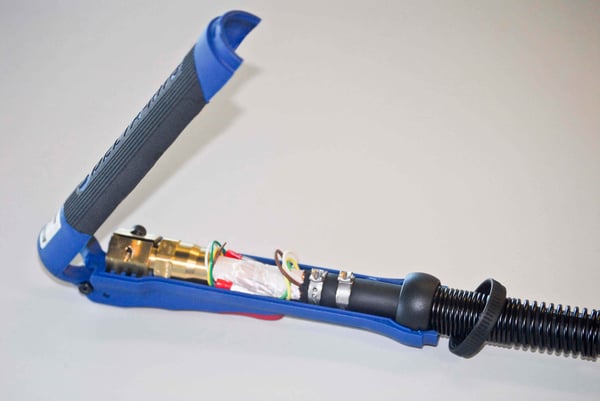
These are and should be quick jobs – typically 10 minutes or less – and unlike doing the cone nut or re-crimp yourself, you won’t lose amperage on the cable and de-rate the welding gun going this maintenance route. This is also a good cost-effective route to go if you have a MIG gun and need to lengthen it to go further across the shop or access a weld for a pretty minimal cost.
To make the soundest decisions for your welding operation, knowing what the possibilities are and the ways it can be beneficial for you are huge parts of the equation. Don’t hesitate to ask your welding supply rep or the OEM rep regarding options or custom capabilities on your MIG guns - manual or robotic. Chances are they’ll have something that can meet your need, or provide other options that may get you closer than you were before.


